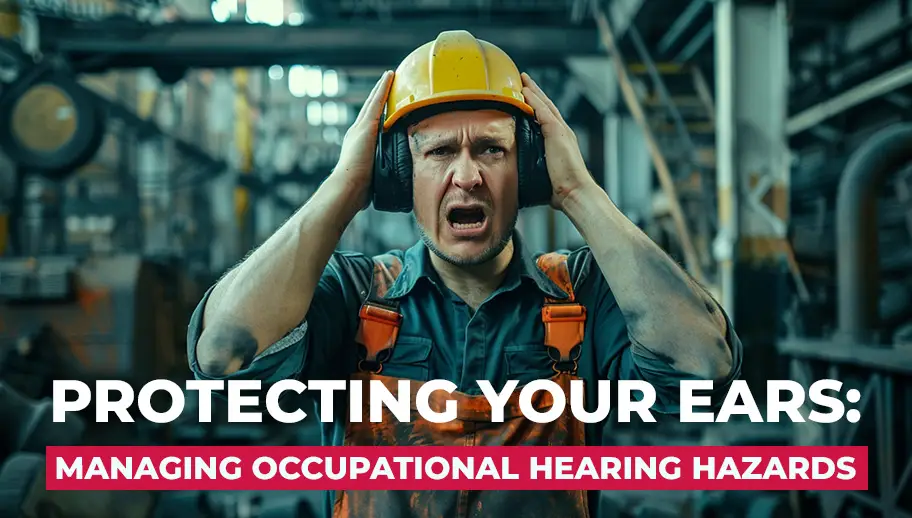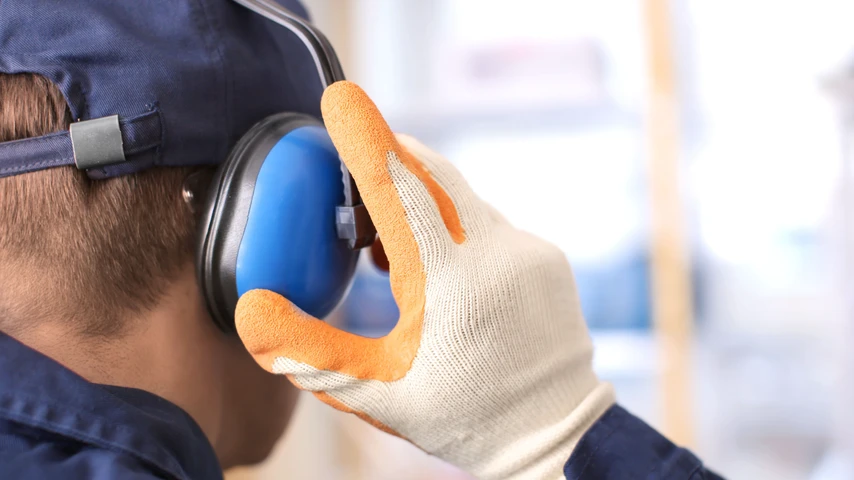Managing Occupational Hearing Hazards


Hazardous noise is a known workplace hazard that can lead to temporary or permanent hearing loss, tinnitus, and other types of injuries.
As an employer, it is your responsibility to identify and manage the risks associated with noise-related injury in the workplace.
Occupational hearing loss can occur due to noise, vibration, and ototoxic substances. Mechanical impacts, high-velocity air or fluid flow, and vibrating surfaces can cause hazardous noise in a workplace.
Hard, non-absorbent surfaces can also increase noise levels due to reverberation. Exposure to both hand-arm vibration (HAV) and whole-body vibration (WBV) can increase the likelihood of hearing loss.
Ototoxic substances like solvents, heavy metals, asphyxiants, and some medications can also lead to hearing loss. It is recommended that the noise exposure of workers exposed to any ototoxic substances be reduced to 80 dB(A) or below and they should undergo audiometric testing.
Control measures such as substitution, isolation, local ventilation, and personal protective equipment should be implemented to reduce chemical exposures.

Hazardous noise can lead to:
Hearing loss can be temporary or permanent, and can get worse over time. Permanent hearing loss can’t be cured. Workers who are exposed to noise and vibration or ototoxins together may be more likely to suffer from hearing loss.
To identify the hazard all workplaces should undertake noise assessments, use suitable control measures, provide personal protective equipment to workers, and test noise levels.
Loud noise is not the only cause of occupational hearing loss. Vibrations and ototoxic substances can also cause damage to the ears, and also require risk assessments and management.
The model Code of Practice: Managing Noise and Preventing Hearing Loss at Work guides you on how to do a workplace noise assessment, and includes a ‘noise ready reckoner’ tool to calculate exposure. Risk of noise-related injury increases depending on how loud the noise is and how long the worker is exposed to it.
The noise standard states that workers should not be exposed to levels higher than 85 decibels over 8 hours of work. This is used as a guide for calculation of higher decibels for shorter time periods, and is an indication of when noise-reducing PPE should be worn.
According to Safe Work Australia the noise level while working should:
If, after conducing a full assessment, it is deemed that workers are at risk, ensure that they are supplied with appropriate PPE and that causes of loud noise are mitigated as appropriate.
Vibration exposure can cause hand-arm vibration syndrome (HAVS), a condition that can cause long-term damage to the nerves, blood vessels, and joints in the hands and arms.
Workers who may be at risk include those who use vibrating tools such as:
Employers should take the following steps to control vibration hazards:
Ototoxic substances can damage the inner ear and lead to permanent hearing loss or tinnitus. The most common routes of entry for these ototoxic substances are via skin absorption, inhalation and, to a lesser extent, ingestion (mainly due to poor personal hygiene practices at work).
There are three major classes of ototoxic substances:
Workers who are particularly at risk of exposure to these substances through skin absorption, inhalation, and ingestion include those in industries such as:
Employers should take the following steps to control ototoxic hazards:
Noise-induced hearing loss is the single greatest cause of permanent hearing loss in Australia - and it's also the most preventable. Over the past four years more than 10,000 workers have been affected by noise-related injuries in NSW workplaces, with more than 90 per cent left permanently disabled.
First aid training is essential for preventing and managing injuries in the workplace. By completing first aid training, workers are better equipped to identify, manage and prevent injuries in the workplace. Australia Wide First Aid provides comprehensive first aid training courses for workplaces and individuals. The courses cover various topics, including managing injuries related to hazardous noise exposure.
Exposure to hazardous noise in the workplace can result in serious injuries, such as hearing loss and tinnitus. Employers must implement appropriate measures to protect their workers from noise-related injuries. However, despite taking all preventive measures, accidents can still occur in the workplace. That is why first aid training is essential for workplaces and individuals.
Here are some important points to highlight the importance of first aid training in managing noise-related injuries:
Australia Wide First Aid offers a range of training courses tailored to meet the needs of different workplaces. Their courses are designed to equip workers with the skills and knowledge necessary to manage injuries related to hazardous noise exposure. By completing these courses, workers are better prepared to identify and manage noise-related injuries, and prevent accidents from occurring in the first place.
As an employer, it is important to recognize that hazardous noise is a workplace danger that can cause permanent or temporary hearing loss, tinnitus, and other injuries. Therefore, it is your responsibility to identify and manage any risks associated with noise-related injuries at work. This can be accomplished by following a systematic process that involves identifying sources of noise that could cause hearing loss, assessing the risks involved, implementing risk control measures, and reviewing them regularly to reduce the risk of injury.
Providing first aid training to workers is essential for preventing and managing injuries in the workplace.
October 1, 2024
Almost every job involves using the body to carry out some type of manual task. Some tasks may be hazardous, causing injuries such as musculoskeletal disorders (MSDs). Knowing how to manage them is a legal responsibility of all workplaces.

January 10, 2024
In Australia, workplace safety is a top priority, and First Aid plays a crucial role in ensuring the well-being of employees. Workplaces are expected to adhere to specific regulations and guidelines outlined by Safe Work Australia. How does your workplace stack up?

November 24, 2023
No matter how experienced you are as an outdoor activity leader, there are some things you should always do to keep your group safe. Nature can be unpredictable, and so it’s best to be prepared.